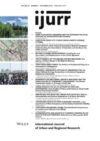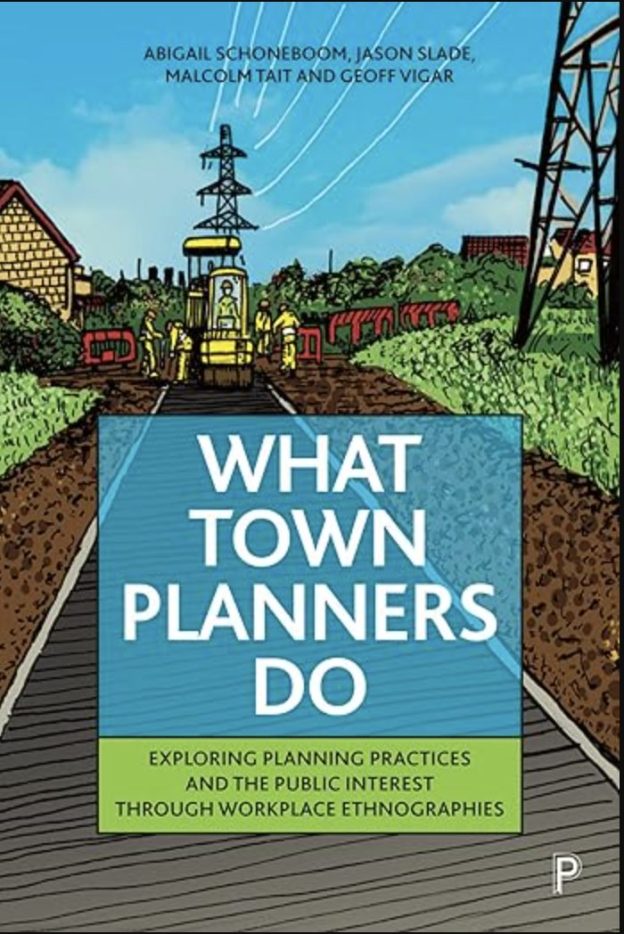What Town Planners Do is a refreshing book that goes against the mainstream of contemporary planning research in many ways. As the authors note (p. 182), when planning scholars set out to study the changing nature of urban planning, they often start from transformations in the planning system rather than from planning on the ground. In What Town Planners Do, in contrast, Schoneboom, Slade, Tait and Vigar turn their focus to the daily situated practices of town planners, working from the hypothesis that many of the recent changes in the broader political-economic context of planning—manifested as austerity politics, the commercialization of planning and the blurring of lines between public and private sector planning—substantially influence the everyday lives of town planners in the UK.
The title of the book suggests that, in particular, the study addresses the possibilities available to planners under the current neo-liberal societal and political conditions to work for the public interest. Yet many other topics are also covered, including the challenges that planners face in balancing between their private and working lives. The book begins with a brief overview of the history of the planning profession in the UK and a review of existing research on planners’ work both here and further afield. This professional and academic contextualization is followed by the core of the book, which comprises four case studies carried out using organizational ethnography.
Organizational ethnography is not a method that has commonly been used in planning studies, perhaps because it is so resource-intensive. For this study it involved the researchers—mainly Schoneboom and Slade—carrying out immersive and participatory observation of the planners’ daily practices in four organizational contexts: two local authorities, the first of which is described as ‘privatized’ (Southwell) and the second as currently ‘commercializing under austerity politics’ (Bakerdale); and two consultancy companies, the first of which is labelled as a ‘values-driven’ and ‘global’ consultancy (Simpsons) and the second as a ‘regular’ consultancy (OIP). These observations were complemented by elements of interview methodology, which has traditionally dominated studies on planning practice. Nonetheless, the advantage of ethnographic observation is that it can reveal whether the actions of the research subjects match with their own descriptions of their actions—in other words, whether planners are ‘walking the talk’.
Notes from ethnographic fieldwork are typically heavily detailed and lengthy and, as such, they are not very reader-friendly. Because of this, the research team of What Town Planners Do made significant efforts to come up with catchy storylines—perhaps to some extent compromising the rigour of documenting the results of their ethnographic work. From the reader’s perspective, however, this seems to be a successful strategy, since the final product is both entertaining and informative.
When reading the book, I was thrown back to the year 2013 when I worked as a visiting scholar in the UK and became hooked on the BBC reality TV show ‘The Planners’. For a Nordic visitor, this show described the nature of planning in the UK far more vividly and effectively than most of the academic publications and seminars. In fact, in What Town Planners Do, one of the planners being observed asked the observer-researcher whether the research project was going to produce ‘an academic version of “The Planners”’, to which the observer admitted (at least half-seriously) that this was the goal, ‘though almost certainly with a smaller audience’ (p. 167).
So what kind of audience did the authors have in mind when producing this book? Although they do not answer this question directly, I would imagine it being useful not only for the community of researchers interested in the UK’s contemporary planning practice and culture but also, for instance, planning students who wish to get a glimpse of the professional life of planners. In addition, the book might increase understanding of discretionary planning systems and development control among those readers who have been educated within the tradition of regulatory and plan-based planning.
From a Nordic perspective, the daily work of UK planners who are constantly involved in assessing individual development projects of various scales with various stakeholders appears far more exciting than the work of planners who work within regulatory planning systems. While none of the research subjects deemed their work among various stakeholder groups to be boring, the constant minor confrontations with these groups often seemed to compel planners to compromise on their ideals. This in turn caused frustration and disillusionment in the planners being observed.
The book’s sub-title—Exploring Planning Practices and the Public Interest through Workplace Ethnographies—suggests that the authors want to make a bridge between everyday planning practice and the current, often somewhat abstract planning-theoretical discourses around public interest. Yet there is surprisingly little theorizing in the book, and the bridge-building is mostly left to the reader. The case studies certainly leave us with some important takeaways related to the notion of public interest, however. Most importantly, the authors conclude that the reputation of planning as a profession concerned with enhancing place quality is at risk when planning becomes ever more dispersed into different types of public and private organizations. The work of individual planners today is increasingly fragmentary and ‘narrow’, and as such, their possibilities for contributing to (for instance) sustainability goals are often limited (p. 195).
These conclusions are not the book’s main contribution to planning research and practice, however. Its key value lies in the rich and ‘thick’ descriptions of the daily interactions between planners and various stakeholder groups, as well as between public and private sector planners. The practice stories indicate how planners in both the public and private sectors can still find small windows of opportunity through which to make a difference. Most importantly, even though the book shows that the influence of the planning profession is currently diminishing, it nonetheless offers inspiration for (future) planners to reflect critically on current planning practices and to develop everyday tactics for making planning work more influential and meaningful again.
Hanna Mattila, Aalborg University, Denmark
Abigail Schoneboom, Jason Slade, Malcolm Tait and Geoff Vigar 2023: What Town Planners Do: Exploring Planning Practices and the Public Interest through Workplace Ethnographies. Bristol: Policy Press/Bristol University Press. Cover used with permission of Policy Press/Bristol University Press
Views expressed in this section are independent and do not represent the opinion of the editors.

